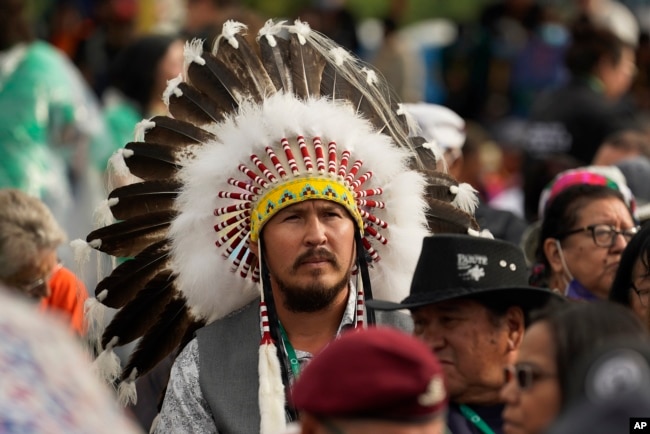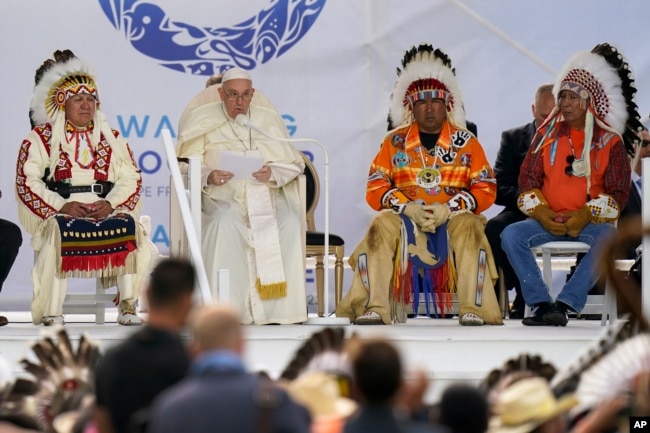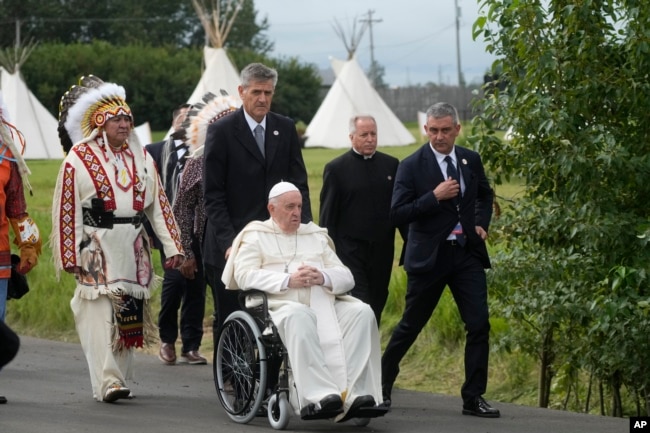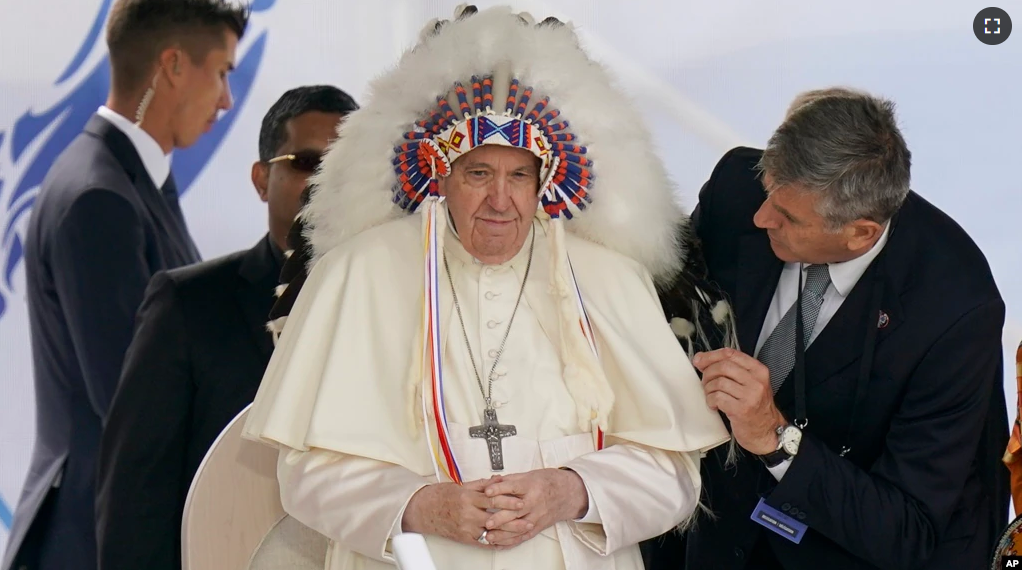Pope Francis visited a small community in the Canadian province of Alberta on Monday to offer an apology for the Roman Catholic Church’s mistreatment of native people.
The main native groups of Canada include the Metis, First Nation and Inuit.
The apology was described as “long-awaited.”
Appeal for forgiveness
Francis is following through on a decision he made last April. That is when a group of indigenous people went to the Vatican to speak with the church leader. After the meeting, the Pope called the treatment of Canada’s native people “deplorable,” and asked for forgiveness and promised to make his July visit.
When he arrived at the event in the small community of Maskwacis, he said: “I humbly beg forgiveness for the evil committed by so many Christians against the Indigenous peoples.” The Pope spoke in his native language of Spanish and his words were translated into English.
Many of those in attendance wore traditional clothing decorated with beads and feathered head coverings. The Pope arrived in a wheelchair and watched traditional songs and dances from a raised platform.
Maskwacis is the location where the Ermineskin Indian Residential School once stood. It is about 100 kilometers south of the city of Edmonton, Alberta.
The schools were set up by Roman Catholic missionaries to educate the children of indigenous groups in Canada. Missionaries are religious people who go to other countries and try to get people to join their religion.

In their work, the missionaries set up religious schools that operated for about 100 years, ending in the 1970s. However, native children were separated from their families at the missionary schools.
Because they were away from home, the children were not able to learn traditions from older family members and community leaders.
While they were at the schools, some of the children were treated badly. Some were physically abused by school leaders and others were sexually abused. About 150,000 young people went to the schools over the years.
Government policy
The Canadian government has also talked about its part in permitting the schools and harming the children. The Canadian government admitted the children were given physical punishment for speaking their native language while at the schools. Canadian Prime Minister Justin Trudeau was also in Alberta with the Pope. He offered an apology for an “incredibly harmful government policy” last year.
Native leaders say they believe the bad treatment of the children prevented them from doing well as adults. While Catholics operated most of the residential schools, others were led by Protestants. Protestants are another Christian religious group different from Catholics.
In addition to the abuse, thousands of children died from disease, fires and other causes. Investigators say they have found locations at the schools where children who died may have been buried.

The Pope took responsibility for the church’s cooperation with the Canadian policy of mixing native people into Canadian society.
The Pope called it “cultural destruction.” He also said the missionaries of the time were only going along with the policy of the Canadian government.
He went on to say that remembering the bad actions of the Catholic missionaries and the Canadian government could cause sadness and anger. But he said it was “necessary.” He said it was “right to remember” the bad things that happened because forgetting leads to indifference.
He also said that asking forgiveness is only the first step in the healing process. He promised an investigation into the past and research into ways the Catholic Church can help survivors.
Francis apologized for not being able to visit all of the indigenous people of Canada who have invited him, noting the size of the country.

Organizers wanted to make sure as many native people as possible could be present.
‘Mixed emotions’
Maskwacis is a center for four groups of Cree people. It is now home to a school that is run by local people and supports the study of native culture.
Greg Desjarlais is a leader of a local native group. He said there are “mixed emotions” across Canada about the Pope’s visit. He said the visit brings up sad feelings about the young people who died at the schools, but also offers hope that people might start to feel better after an apology.
“Our people have been traumatized,” he said. “Now I hope the world will see why our people are so hurt.”

On Monday, the Pope also visited a Catholic church whose members are mostly indigenous people. The church includes native languages and traditions in its religious ceremonies.
Fernie Marty is a religious leader called an elder. Marty said: “I never in my life thought we would see a pope here at Sacred Heart Church.”
Francis will also visit other native groups in Canada. His six-day trip includes visits to other sites in Alberta, a visit to the province of Quebec and to the territory of Nunavut.
I’m Dan Friedell.
Dan Friedell adapted this story for Learning English based on a report from the Associated Press.
__________________________________________________________________
Words in This Story
await – v. to wait for someone or something
incredible – adj. difficult or impossible to believe
indigenous – adj. produced, living, or existing naturally in a particular region or environment
beg – v. to ask strongly for something
decorate – v. to add something that will make an item look nicer
location –n. a place
trauma – n. a very difficult or unpleasant experience that causes someone to have mental or emotional problems usually for a long time
